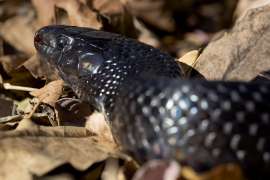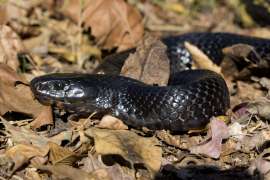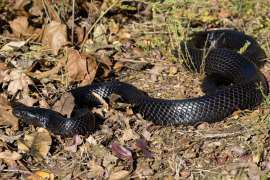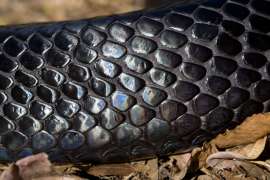Eastern Indigo Snake
Eastern Indigo Snake
Eastern indigo snakes are the largest native non-venomous snake in the United States. Rather than relying on constriction to disable their wide variety of prey items, they simply overpower their prey with their muscular jaws and swallow it whole. Their conservation status is of concern because their preferred habitat, the longleaf pine forest, has been heavily fragmented by agricultural and logging practices.
Drymarchon couperi
Carnivore
North America [VIEW MAP]
Scrublands, Woodlands
Since these snakes are being reared for a conservation program in our behind-the-scenes Conservation Breeding Center, they may not currently be seen by guests.
Photos and Videos
Indigo snakes are heavily reliant on longleaf pine ecosystems in the southeastern U.S. Their habitat specialization and their need for very large expanses of undisturbed habitat have vastly reduced their numbers in most areas of their range. They also regularly use the burrows of gopher tortoises as retreats, and gopher tortoises are similarly restricted to un-impacted longleaf pine habitats.
This is the largest non-venomous snake in the U.S., reaching up to 8 feet in length. Males are typically larger than females. Their name derives from their dark black coloration, which reflects iridescent shades of blue, purple and red in the sunlight. Most snakes have a relatively weak bite force, but eastern indigo snakes have unusually muscular jaws that are used to physically overpower their prey.
These snakes may reach ages approaching 20 years. Males and females usually only come together for courtship and breeding, which takes place from autumn into early spring. Females may breed with multiple partners during the breeding season.
Females lay four to 12 eggs which take approximately three months to hatch. Beyond construction of a nest, or simply laying the eggs in an unused arm of a gopher tortoise burrow, there is no parental care.
Since these snakes are being reared for a conservation program in our behind-the-scenes Conservation Breeding Center, they may not currently be seen by guests.
Eastern indigo snakes historically ranged along the Coastal Plain of the southeastern U.S. They are now missing from most of their historic range, with healthy populations appearing to persist only in parts of southern Georgia and Florida.
While usually associated with longleaf pine forests, these snakes also will use sandhills, pine flatwoods, wetlands, coastal scrub, and other habitat types.
In the wild, these snakes have one of the widest diets of any snake. They literally will eat any animal that they can overpower and consume, including large insects, small turtles, and every variety of other reptile or bird, mammal, amphibian and fish. They are immune to the bite of the vipers, and so they regularly eat rattlesnakes, cottonmouths and copperheads. At the Zoo, we offer a similarly wide variety of all sorts of small animals.
Zoo Atlanta is an active partner with state agencies in Georgia and Alabama, the U.S. Fish & Wildlife Service, the NGO Orianne Society, and Auburn University on a broad-scale project to head-start young snakes at Zoo Atlanta and translocate them to historical sites in the Conecuh National Forest in Alabama, as well as to establish robust conservation breeding programs.




